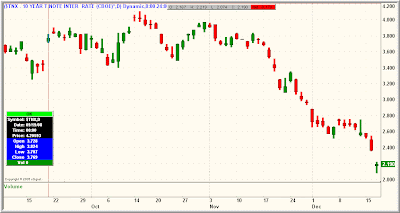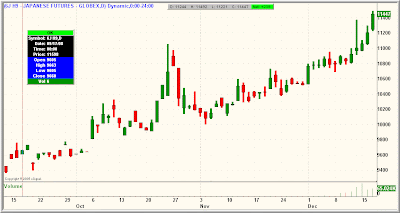Although I've posted details in the past, I decided to respond to recent questions about the construction of the Cumulative Adjusted NYSE TICK with two dedicated blog posts. This post will explain the basics of the NYSE TICK. The second will explain my use of the Cumulative Adjusted TICK. For those interested, here is
a link to many past posts on the topic of the TICK, many of which explain how I use the indicator in intraday trading.
So let's start at the start. In an auction market, we have buyers who would like to acquire stock at a relatively low price and sellers who would like to part with their stock at a relatively high price. When all buyers and sellers are assembled in the marketplace, we have an established bid price for the stock (the highest price that buyers will pay) and an established offer price (the lowest price that sellers will accept). The spread between the bid and offer will be quite narrow for actively traded issues; wider for less liquid instruments. Market makers provide liquidity to the market by actively buying bids and selling offers, profiting from the spread.
A patient buyer will work an order in the book below the prevailing price, bidding for the stock or futures contract at a price that he/she considers to be a good value. A patient seller will work an order above the prevailing price, offering the stock at a price that he/she considers to be a good value. As a result, there are always resting orders above and below the market. The number and volume of these orders, arrayed by price, is what is known as depth of market. Market makers and true scalpers (those whose trades last a minute or so or less) often rely on shifts in depth of market to identify when the market is skewed toward buyers or sellers.
If a buyer is not patient and feels that the market is headed higher right now, he/she will not work a bid below the market. Rather, they will "lift the offer": they'll place a market order and accept the best price offered by a seller. When this occurs, the stock or futures contract will typically trade on an uptick, at the offer price in the bid-offer matrix. The motivated seller thinks the market is primed to move lower right now and "hits the bid", accepting the best price offered by a buyer. This transaction will occur on a downtick, at the bid price in the bid-offer matrix.
Over time, we can look at how many transactions across all stocks occur on upticks versus downticks as a way of assessing whether buyers or sellers are more motivated. This statistic is called the
NYSE TICK. It is calculated by the exchange 10 times per minute (every six seconds), typically under the symbol $TICK. A TICK value of +500 means that 500 more stocks traded on upticks than downticks in the most recent six second period; -500 would mean that 500 more issues traded on downticks than upticks. We can track changes in the TICK over time to see whether buyers or sellers are becoming more aggressive on a short-term basis.
A different view of very short-term sentiment is
Market Delta. Instead of looking across a range of stocks to see how many are trading on upticks versus downticks, it calculates the volume of shares or futures contracts traded at the market bid versus offer for a single instrument. This is very helpful when the instrument may be imperfectly correlated to the broad stock market. Many times, for instance, we can see a neutral Market Delta reading in the ES futures when NYSE TICK is quite positive or negative. Most often, this means that sentiment is neutral among large cap issues, but more positive or negative among the large number of small cap issues that are part of the NYSE TICK universe.
Finally, we can use the same logic as TICK to construct measures of
money flow. We multiply the price of the stock or futures contract times the volume traded for each transaction. This gives us the dollar volume of the transaction. If the transaction occurred on an uptick, we add the dollar volume to a cumulative total; if it occurred on a downtick, we subtract the dollar volume from the cumulative total. This money flow measure identifies whether large market participants (those trading larger volumes) are predominantly lifting offers or hitting bids.
These are among my favorite market indicators, because they are grounded in the actual auction market behavior of participants. They do not rely upon esoteric interpretations of chart patterns, oscillator readings, or market waves. The minute-to-minute readings of TICK and Market Delta help intraday traders understand whether markets are becoming stronger or weaker. When we cumulate these readings over time, we can assess sentiment shifts over longer time frames.
In my next post in this series, we'll look at how you can cumulate the NYSE TICK and use the data for an understanding of market trends. Please note that I update the Cumulative Adjusted NYSE TICK every Monday in my weekly indicators post; I post money flow numbers for the Dow stocks each morning prior to the start of trading days
via Twitter.
.

































